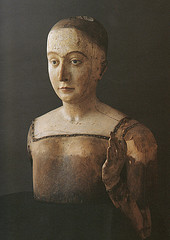Cotton Vespasian F XIII (f. 118r) contains a note which reads thys boke ys myn elysabeth the kyngys dowghtyr, or ‘This book is mine Elizabeth, the king’s daughter’. From the unpracticed handwriting, it appears princess Elizabeth was still a child when she wrote it. Unfortunately, the note has been cut out and is now part of a larger volume containing various documents pasted out of context and bound together in the same covers, so we don’t know which book the little princess claimed as her own.
Beneath Elizabeth’s scribble is an explanatory note in French, identifying the girl as filye du Roy Edwarde le quarte quatrieme, or ‘the daughter of king Edward IV’. If this is true, it means the note was written by none other than Elizabeth of York, a future queen of England.

Elizabeth lived during a tumultuous period and was related to several well-known figures of the day. She was a Yorkist princess but ended up married to a Tudor. The two princes in the Tower, who would have been next in line to the throne, but disappeared in 1483, were her younger brothers. The man who is often blamed for their deaths, Richard III, was her uncle. Uncle Richard, in turn, was killed in a battle against her future husband, Henry Tudor.
Elizabeth herself was not one of the politically active women of the day. She lived in the shadow of her mother-in-law, Lady Margaret Beaufort, a powerful Tudor matriarch, who is often credited with masterminding the marriage between Elizabeth and Henry to unite the houses of York and Lancaster and bring an end to the Wars of the Roses. Even though her marriage to Henry VII was a political arrangement, it seems to have been a happy one. Elizabeth had seven children, three of whom ended up becoming kings and queens. Her son Henry was later crowned as Henry VIII. Her daughter Margaret became the queen of Scotland and her daughter Mary, the queen of France. Elizabeth’s death in 1503 is said to have left Henry VII devastated.
.png)
Middle English written by a woman
There is, however, something else about this short ownership note which makes it rare. It is an example of a Middle English text, in which we can be fairly certain that both the scribe and the author is a woman.
Texts written by women were typically copied by male scribes. For example, Margery Kempe dictated her spiritual autobiography, known as the Book of Margery Kempe, to two scribes, both of whom were men. Margaret Paston, who was responsible for many of the letters in the collection known as the Paston letters, also always dictated to male scribes.
What is more, in medieval England, the majority of scribes are anonymous, as they rarely signed their names. However, a few instances exist where scholars have identified texts copied by nuns. Such cases are more common on the Continent than in the British Isles, but a twelfth-century Latin religious text from Nunnaminster (Corpus Christi College, Cambridge, MS 173) was signed by a scriptrix ’scribess/female copyist’. She wrote in a professional-quality Gothic hand that does not differ in any way from the handwriting of male scribes from the same period. It is worth noting that this is a female scribe copying a text written by man and that the text was not in Middle English.
Veronica O’Mara identified a likely candidate for an original monastic text written by a woman, which could plausibly predate 1500. MS Lambeth Palace 546 is a collection of devotional texts associated with the Birgittine monastery of Syon, and it includes an apparently unique devotional piece that was written by one sister to another. The manuscript also features the name ‘Sister E W’, which O’Mara tentatively identifies as Sister Elizabeth Woodford (d. 1523). While this identification is plausible, it is also possible that the text dates from after 1500, which would make it not medieval.
After 1500, the number of surviving written texts (including by women) increased. Female literacy nevertheless remained considerably lower than that for men, and in early Tudor England only about 30% of the population could read.
However, the short letter by a very young Elizabeth of York seems to have been both composed by her and written in her own hand. Since it dates from the fifteenth century, it is from the Middle English period. We consequently seem to have that rarity, a Middle English text both composed and copied by a woman.
We cannot be sure how old Elizabeth was when she wrote the note. While the French note identifying her as ‘the daughter of king Edward IV’ is likely to be contemporary, a later hand has added a year in Arabic numerals that appears to be 1461 next to it (possibly 1462). This may appear to be in conflict with the year of Elizabeth’s birth, which was 1466, and could therefore cast doubt on the identification. It seems, however, that the note is related to Edward IV rather than his daughter, since 1461 is the year that he became king.

Sources:
Pamela R. Robinson. ‘A Twelfth-Century Scriptrix from Nunnaminster’. In Pamela R. Robinson and Rivkah Zim (eds), Of the Making of Books: Medieval Manuscripts, their Scribes and Readers: Essays presented to M. B. Parkes (Aldershot, 1997), pp. 77-93.
Veronica O’Mara. ‘A Middle English Text Written by a Female Scribe’, Notes & Queries (37: 4), December 1990, pp. 396-398.
Margaret Paston (This is Paston Portal)
The Book of Margery Kempe, Digitised Manuscripts (bl.uk)
Cotton MS Vespasian F XIII, Digitised Manuscripts (bl.uk)
